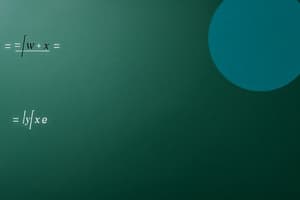Podcast
Questions and Answers
Which of the following correctly describes the difference between mathematical language and natural language?
Which of the following correctly describes the difference between mathematical language and natural language?
- Natural language uses specialized symbols, while mathematical language does not.
- Both languages are equally effective for expressing complex ideas with the same level of clarity.
- Mathematical language relies heavily on context, whereas natural language is precise and unambiguous.
- Mathematical language aims for clarity and precision, avoiding ambiguities present in natural languages. (correct)
Given the set $A = {1, 2, 3, 4, 5}$, which of the following statements is true?
Given the set $A = {1, 2, 3, 4, 5}$, which of the following statements is true?
- $6 ∈ A$
- $0 ∈ A$
- $4 ∈ A$ (correct)
- $3 ∉ A$
Which of the following sets is equivalent to the set {x | x is an even positive integer less than 10}?
Which of the following sets is equivalent to the set {x | x is an even positive integer less than 10}?
- {1, 2, 3, 4, 5, 6, 7, 8, 9}
- {0, 2, 4, 6, 8}
- {2, 4, 6, 8, 10}
- {2, 4, 6, 8} (correct)
If $A = {1, 2, 3}$ and $B = {3, 4, 5}$, what is $A ∪ B$?
If $A = {1, 2, 3}$ and $B = {3, 4, 5}$, what is $A ∪ B$?
Given $U = {1, 2, 3, 4, 5, 6, 7, 8}$, and $A = {2, 4, 6, 8}$, what is the complement of A (A')?
Given $U = {1, 2, 3, 4, 5, 6, 7, 8}$, and $A = {2, 4, 6, 8}$, what is the complement of A (A')?
Which of the following is an example of a relation?
Which of the following is an example of a relation?
If set A is defined as all even numbers and set $B$ is defined as all multiples of 3, which of the following would be in the intersection of sets A and B ($A ∩ B$)?
If set A is defined as all even numbers and set $B$ is defined as all multiples of 3, which of the following would be in the intersection of sets A and B ($A ∩ B$)?
Let $A = {x | x ∈ ℕ, x < 5}$ and $B = {x | x ∈ ℤ, -2 < x < 3 }$. What is A - B?
Let $A = {x | x ∈ ℕ, x < 5}$ and $B = {x | x ∈ ℤ, -2 < x < 3 }$. What is A - B?
Which of the following statements is true regarding a relation R on a set A to be considered an equivalence relation?
Which of the following statements is true regarding a relation R on a set A to be considered an equivalence relation?
Given set A = {a, b, c}, which of the following relations on A is reflexive?
Given set A = {a, b, c}, which of the following relations on A is reflexive?
If A = {1, 2, 3} and B = {x, y}, what is the cardinality (number of elements) of the Cartesian product A × B?
If A = {1, 2, 3} and B = {x, y}, what is the cardinality (number of elements) of the Cartesian product A × B?
Which of the following is an example of a unary operation?
Which of the following is an example of a unary operation?
For a function $f: A \rightarrow B$ to be valid, which of the following conditions must be met?
For a function $f: A \rightarrow B$ to be valid, which of the following conditions must be met?
What is the domain of the function $f(x) = \frac{1}{x-2}$?
What is the domain of the function $f(x) = \frac{1}{x-2}$?
What is the range of the function $g(x) = x^2$?
What is the range of the function $g(x) = x^2$?
Given $f(x) = x + 1$ and $g(x) = x^2$, what is $(f \circ g)(x)$?
Given $f(x) = x + 1$ and $g(x) = x^2$, what is $(f \circ g)(x)$?
Which of the following functions has a domain of all real numbers?
Which of the following functions has a domain of all real numbers?
Which of the following relations on the set A = {1, 2, 3} is symmetric?
Which of the following relations on the set A = {1, 2, 3} is symmetric?
Flashcards
What is a set?
What is a set?
A well-defined collection of distinct objects, treated as a single entity.
What does '∈' mean?
What does '∈' mean?
Symbol indicating an element belongs to a set.
What is the roster method?
What is the roster method?
Defining a set by listing its elements within curly braces.
What is set-builder notation?
What is set-builder notation?
Signup and view all the flashcards
What are Natural Numbers (ℕ)?
What are Natural Numbers (ℕ)?
Signup and view all the flashcards
What are Integers (ℤ)?
What are Integers (ℤ)?
Signup and view all the flashcards
What is the union of sets (A ∪ B)?
What is the union of sets (A ∪ B)?
Signup and view all the flashcards
What is a Relation?
What is a Relation?
Signup and view all the flashcards
Binary Relation
Binary Relation
Signup and view all the flashcards
Cartesian Product (A × B)
Cartesian Product (A × B)
Signup and view all the flashcards
Reflexive Relation
Reflexive Relation
Signup and view all the flashcards
Symmetric Relation
Symmetric Relation
Signup and view all the flashcards
Transitive Relation
Transitive Relation
Signup and view all the flashcards
Equivalence Relation
Equivalence Relation
Signup and view all the flashcards
Operation
Operation
Signup and view all the flashcards
Function
Function
Signup and view all the flashcards
Domain
Domain
Signup and view all the flashcards
Range
Range
Signup and view all the flashcards
Study Notes
- Mathematics uses a unique language to communicate concepts precisely.
- This language includes specific vocabulary, symbols, and grammatical rules.
- Mathematical language is clear, avoiding ambiguities found in natural languages.
- It is brief, precise, and expresses complex ideas efficiently.
Sets
- A set is a well-defined collection of distinct objects, treated as a single object.
- Elements or members are the objects within a set.
- Sets are represented by uppercase letters (e.g., A, B, C).
- Elements are represented by lowercase letters (e.g., a, b, c).
- "∈" indicates set membership; "a ∈ A" means "a is an element of A."
- "∉" indicates non-membership; "b ∉ A" means "b is not an element of A."
- Sets defined by listing elements within curly braces use the roster method: {1, 2, 3}.
- Element order in a set is irrelevant; duplicates are ignored.
- Sets defined by a property elements must satisfy use set-builder notation: {x | P(x)}, meaning "the set of all x such that P(x) is true."
- The set of all positive integers is {x | x > 0}.
Common Sets
- Natural numbers (ℕ) are {1, 2, 3, ...}.
- Integers (ℤ) are {..., -2, -1, 0, 1, 2, ...}.
- Rational numbers (ℚ) are {p/q | p, q ∈ ℤ, q ≠ 0}.
- Real numbers (ℝ) include all rational and irrational numbers.
- Complex numbers (ℂ) are {a + bi | a, b ∈ ℝ, i is the imaginary unit}.
- The empty set (∅ or {}) contains no elements.
Set Operations
- The union of sets A and B (A ∪ B) contains elements in A, B, or both: A ∪ B = {x | x ∈ A or x ∈ B}.
- The intersection of sets A and B (A ∩ B) contains elements in both A and B: A ∩ B = {x | x ∈ A and x ∈ B}.
- The difference of sets A and B (A - B) contains elements in A but not in B: A - B = {x | x ∈ A and x ∉ B}.
- The complement of set A (A') contains elements not in A, within a universal set U: A' = {x | x ∈ U and x ∈ A}.
- A universal set contains all elements under consideration.
Relations
- A relation involves a set of ordered pairs.
- It describes relationships between elements of two or more sets.
- A binary relation between sets A and B is a subset of the Cartesian product A × B.
- The Cartesian product A × B includes all possible ordered pairs (a, b) where a ∈ A and b ∈ B: A × B = {(a, b) | a ∈ A and b ∈ B}.
- If A = {1, 2} and B = {x, y}, then A × B = {(1, x), (1, y), (2, x), (2, y)}.
- A relation R from A to B is a subset of A × B.
- If (a, b) ∈ R, 'a is related to b by R', written as aRb.
Types of Relations
- Reflexive: For every a ∈ A, (a, a) ∈ R.
- Symmetric: For every (a, b) ∈ R, (b, a) ∈ R.
- Transitive: For every (a, b) ∈ R and (b, c) ∈ R, (a, c) ∈ R.
- An equivalence relation is reflexive, symmetric, and transitive.
Operations
- Operations are functions that take zero or more inputs (operands) to produce a new value.
- A unary operation takes one operand.
- A binary operation takes two operands.
- Number negation (-x) is a unary operation.
- Addition (+), subtraction (-), multiplication (×), and division (÷) are binary operations.
- A binary operation on a set A is a function from A × A to A.
- The operation takes two elements from A and returns an element also in A.
- Addition is a binary operation on integers (ℤ); adding two integers yields another integer.
Functions
- Functions map each element from the domain to exactly one element in the codomain.
- A function f from A to B, denoted f: A → B, means for every a ∈ A, there's a unique b ∈ B such that (a, b) ∈ f.
- Each input has only one output.
- If f: A → B and (a, b) ∈ f, then f(a) = b.
- 'a' is the function's argument or input, and 'b' is the function's value or output.
- A is the domain of f, and B is the codomain of f.
- The range of f includes all actual output values of f.
- The range is a subset of the codomain.
- Range(f) = {f(a) | a ∈ A}.
Domain and Range
- The domain is all possible input values for which the function is defined.
- For f: A → B, A represents the domain.
- The range includes all actual output values produced from all possible domain inputs.
- The range is a subset of the codomain.
- Finding a function's domain means identifying values that make the function undefined.
- Division by zero must be avoided to keep a function defined.
- Taking the square root of a negative number (in real numbers) must be avoided.
- Taking the logarithm of a non-positive number must be avoided.
Examples of domain and range
- For f(x) = 1/x, the domain is all real numbers except 0 (ℝ - {0}), and the range is also ℝ - {0}.
- For g(x) = √x, the domain is all non-negative real numbers ([0, ∞)), the range is also [0, ∞).
- For h(x) = x^2, the domain is all real numbers (ℝ), and the range is all non-negative real numbers ([0, ∞)).
Function Composition
- The composition of functions f and g, (f ∘ g)(x) = f(g(x)).
- The range of g must be a subset of the domain of f for the composition to be defined.
Studying That Suits You
Use AI to generate personalized quizzes and flashcards to suit your learning preferences.




